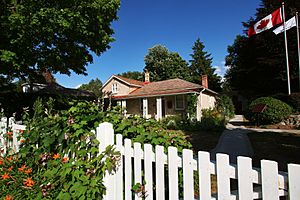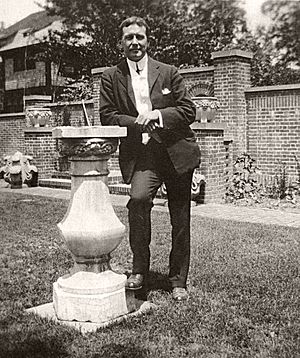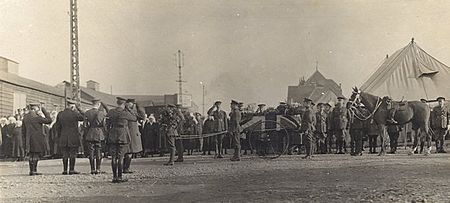John McCrae facts for kids
Quick facts for kids
Lieutenant-Colonel
John McCrae
|
|
|---|---|
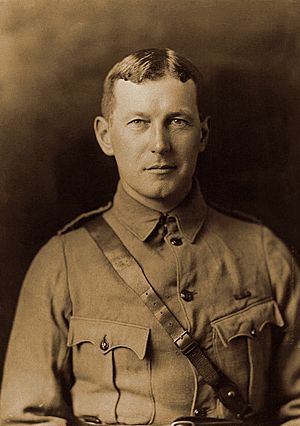
McCrae c. 1914
|
|
| Born | November 30, 1872 |
| Died | January 28, 1918 (aged 45) Boulogne-sur-Mer, France
|
| Occupation | Poet, physician, author, Lieutenant Colonel of the Canadian Expeditionary Force |
| Known for | Author of "In Flanders Fields" |
| Relatives | Thomas McCrae (brother) |
Lieutenant-Colonel John McCrae (born November 30, 1872 – died January 28, 1918) was a Canadian poet, doctor, writer, artist, and soldier. He served during World War I and was a surgeon during the Second Battle of Ypres in Belgium. He is most famous for writing the well-known war poem "In Flanders Fields". McCrae passed away from pneumonia near the end of the war. His famous poem is a type of sad song or poem, often written for someone who has died.
Contents
John McCrae's Early Life and Education
John McCrae was born in McCrae House in Guelph, Ontario. His parents were Lieutenant-Colonel David McCrae and Janet Simpson Eckford. His grandparents were Scottish immigrants. John's father had been a soldier and was involved in local government.
John went to the Guelph Collegiate Vocational Institute. He took a year off from his studies because he often had problems with asthma.
In 1893, while training as an artillery soldier in Kingston, Ontario, John wrote a letter. He described his living quarters as "quite a nobby place." He added that his windows looked out over the bay, which was very pretty.
He worked as a teacher of English and Mathematics in 1894 at the Ontario Agricultural College in Guelph. McCrae then returned to the University of Toronto. He finished his first degree and later came back to study medicine on a scholarship.
While in medical school, McCrae helped other students by tutoring them. This helped him pay for his own education. Two of the students he tutored became some of the first female doctors in Ontario.
McCrae finished medical school in 1898. He first worked at Toronto General Hospital. In 1899, he worked at Johns Hopkins Hospital in Baltimore, Maryland. In 1900, McCrae served as a lieutenant in the Royal Regiment of Canadian Artillery during the Second Boer War. After returning, he became a professor of pathology at the University of Vermont. He taught there until 1911. He also taught at McGill University in Montreal, Quebec.
In 1902, he became a pathologist at Montreal General Hospital. Later, he became an assistant pathologist at the Royal Victoria Hospital in Montreal. In 1904, he became an associate in medicine at the Royal Victoria Hospital. That same year, he traveled to England to study. He became a member of the Royal College of Physicians.
In 1905, McCrae started his own medical practice. He also continued to work and give lectures at several hospitals. In 1908, he became a doctor at the Alexandra Hospital for Contagious Diseases. In 1910, he went on a canoe trip to Hudson Bay with Lord Grey, who was the Governor General of Canada. McCrae served as the doctor for the trip.
McCrae also helped write a medical textbook called A Text-Book of Pathology for College Students of Medicine. It was published in 1912.
John McCrae's Role in World War I

When Britain declared war on Germany in 1914, Canada also joined the war. This was because Canada was part of the British Empire at the time. John McCrae, who was 41, volunteered to serve. He wrote to a friend, "I am really rather afraid, but more afraid to stay at home with my conscience." He was made a Medical Officer and Major for the 1st Brigade CFA (Canadian Field Artillery).
He treated wounded soldiers during the Second Battle of Ypres in 1915. He worked from a small, quickly dug bunker behind a dyke near Ypres. During this battle, McCrae's friend, Lieutenant Alexis Helmer, was killed. Helmer's burial inspired McCrae to write the poem "In Flanders Fields" on May 3, 1915.
From June 1, 1915, McCrae was given a new order. He was to set up No. 3 Canadian General Hospital near Boulogne-sur-Mer, France. For eight months, the hospital operated in large tents. These tents had been donated and shipped from India. But after facing storms, floods, and frost, the hospital moved in February 1916. It moved into an old college building in Boulogne-sur-Mer.
"In Flanders Fields" was first published without an author's name in Punch on December 8, 1915. However, in the magazine's index for that year, McCrae was named as the writer. The poem quickly became one of the most popular poems of the war. It was used in many campaigns to raise money and was translated into many languages.
McCrae found his sudden fame amusing. He wished that people would print his poem correctly, as it was often misspelled. But he was happy if the poem helped people understand their duty.
On January 28, 1918, McCrae passed away. He was still in charge of No. 3 Canadian General Hospital in Boulogne. He died from pneumonia and a severe brain infection at a British hospital in Wimereux, France. He was buried the next day in the Commonwealth War Graves Commission cemetery in Wimereux. His funeral included full military honors. His coffin was carried on a gun carriage. His horse, Bonfire, walked in front of the mourners with McCrae's boots placed backward in the stirrups. McCrae's gravestone lies flat, like others in that part of the cemetery, because the sandy soil is not stable.
The Famous Poem: In Flanders Fields
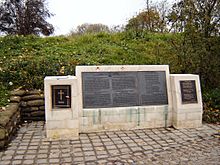
A collection of John McCrae's poems, titled In Flanders Fields and Other Poems, was published after he died in 1918.
In Flanders Fields
In Flanders Fields, the poppies blow
Between the crosses, row on row,
That mark our place; and in the sky
The larks, still bravely singing, fly
Scarce heard amid the guns below.
We are the dead, short days ago
We lived, felt dawn, saw sunset glow,
Loved and were loved, and now we lie
In Flanders fields.
Take up our quarrel with the foe:
To you from failing hands we throw
The torch; be yours to hold it high.
If ye break faith with us who die
We shall not sleep, though poppies grow
In Flanders fields.
–John McCrae
Many stories exist about what inspired the poem. The most common belief is that McCrae wrote "In Flanders Fields" on May 3, 1915. This was the day after he led the funeral and burial of his friend, Lieutenant Alexis Helmer. Helmer had been killed during the Second Battle of Ypres. McCrae wrote the poem while sitting on the back of a medical ambulance. This was near a first aid station at Essex Farm, just north of Ypres. The poppy flower, which is important in the poem, grew in large numbers in the disturbed soil of the battlefields and cemeteries in Flanders.
The Canadian government has placed a memorial to John McCrae at the site of the first aid station. This memorial features "In Flanders Fields." The Belgian government has named this place the "John McCrae Memorial Site."
John McCrae's Lasting Legacy
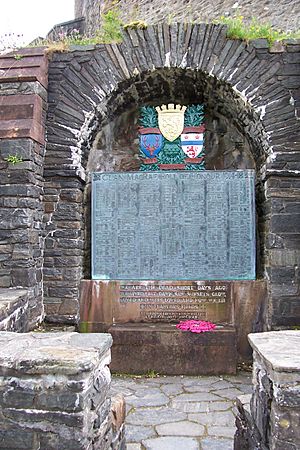
The Canadian Medical Association gives out the John McCrae Memorial Medal. This award honors a health services member of the Canadian Armed Forces for excellent service.
McCrae was recognized as a Person of National Historic Significance in 1946. This means he was an important person in Canada's history.
In 1918, John Philip Sousa wrote music for "In Flanders Fields, the poppies grow."
The Cloth Hall in the city of Ypres in Belgium has a museum called the "In Flanders Fields Museum." It is named after McCrae's poem. There is also a photograph and a short memorial to McCrae in the St George Memorial Church in Ypres. In May 2007, a two-day conference was held to celebrate the 90th anniversary of his most famous poem.
Several schools have been named in McCrae's honor. These include John McCrae Public School in Guelph, John McCrae Public School in Markham, John McCrae Senior Public School in Toronto, and John McCrae Secondary School in Ottawa.
A bronze plaque was put up by the Guelph Collegiate Vocational Institute to remember Lt. Col. John McCrae.
McCrae House has been turned into a museum. The Canadian War Museum has a special gallery called The Lieutenant-Colonel John McCrae Gallery.
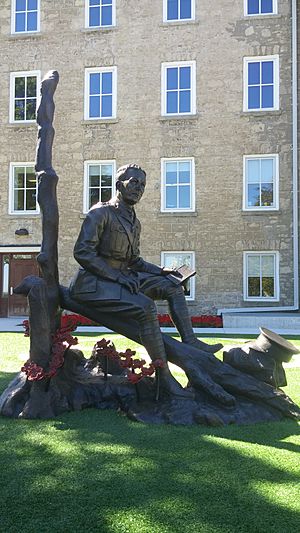
In May 2015, a statue of McCrae was put up in Ottawa, Ontario. The statue shows McCrae as an artillery officer, writing. His medical bag is nearby. The statue also shows the destruction of the battlefield. At his feet are poppies, which are a symbol of remembrance for World War I and all wars since. A copy of this statue was also put up at the Guelph Civic Museum in Guelph in 2015.
The street next to the cemetery where he is buried is named in his honor. It is called "Rue Mac Crae."
Mount McCrae in British Columbia is also named after him.
See also
 In Spanish: John McCrae para niños
In Spanish: John McCrae para niños


